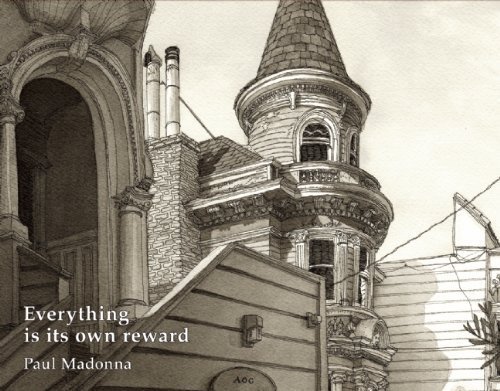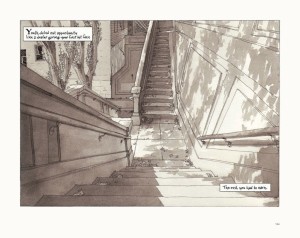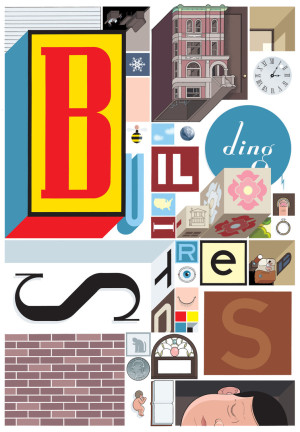Review by Frank Plowright
Paul Madonna’s All Over Coffee strip isn’t widely known outside the USA. Produced weekly for the San Francisco Chronicle until 2105, it meshes text with a pen and ink sketch of an architectural view, predominantly drawn in San Francisco, but occasionally spreading as far afield as Buenos Aires, Paris or Tokyo. The text can be a pithy single line, a few wisps of dialogue or a short story, and is always presented as hand written. In keeping with his aesthetics, explained in a lengthy and illuminating essay, Madonna writes the text directly onto the illustration, whereas earlier material was digitally manipulated.
Madonna is an exceptionally thoughtful creator, explaining that illustrations may sit around for months before the appropriate accompanying text comes to mind, and notes that the title, when it occurred to him, became a guiding principle. It’s the single line accompanying the opening illustration, and given a more thorough airing in the book’s closing piece.
Actually, that’s not entirely true, as the back cover doesn’t feature within, and the inside back cover incorporates a pocket inside which is a folded poster. It’s printed at the size Madonna draws. The illustration is of apartments seen from outside the block, but with no framing reference of sky or street, which is atypical. These are surrounded by lines referring to the unseen inhabitants of those apartments. Perhaps more playful than much of the remaining content, it also represents it well. Madonna aims for an emotional response, and these lines are poignant, intriguing, funny, and thoughtful.
The greater sense of purpose and intent, free poster and absence of any settling in period make this a stronger collection than the very good All Over Coffee. Illustratively, Madonna has an exceptional eye for detail, and while it’s not his desired intention, you can lose yourself in his pictures for a considerable time. This may be mere admiration, trying to figure out just what the device beneath the balcony on page 92 is, or pondering if the world would be a better place for the occasional billboard noting “out there, somewhere”. Madonna also frequently includes strip idents and pithy observations concealed in other places.
It’s perhaps inevitable that not every strip attains the high standards Madonna would set. While the art never falters, even when Madonna has incorporated clever deadline problem devices, the occasional comment is a fortune cookie homily or belabours the obvious. It’s only a very occasional observation that falls flat, but the sorting of strips into themed sections accentuates this with the final grouping incorporating the majority. Sifted throughout the book the lesser content would be barely noticeable.
As with the previous collection, this is a book best left lying around for a while to be absorbed piecemeal rather than read from beginning to end. A greater appreciation results from letting Madonna’s carefully constructed pieces percolate for contemplation.





